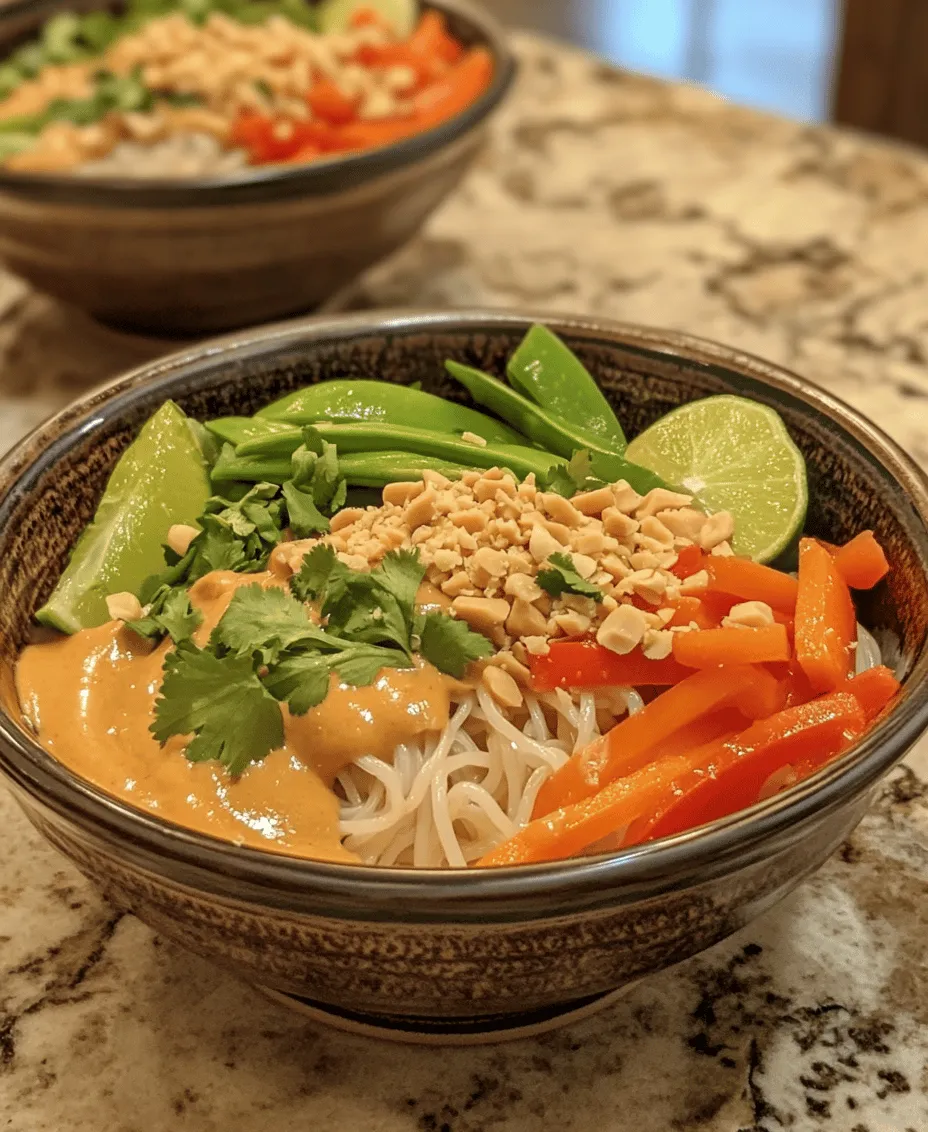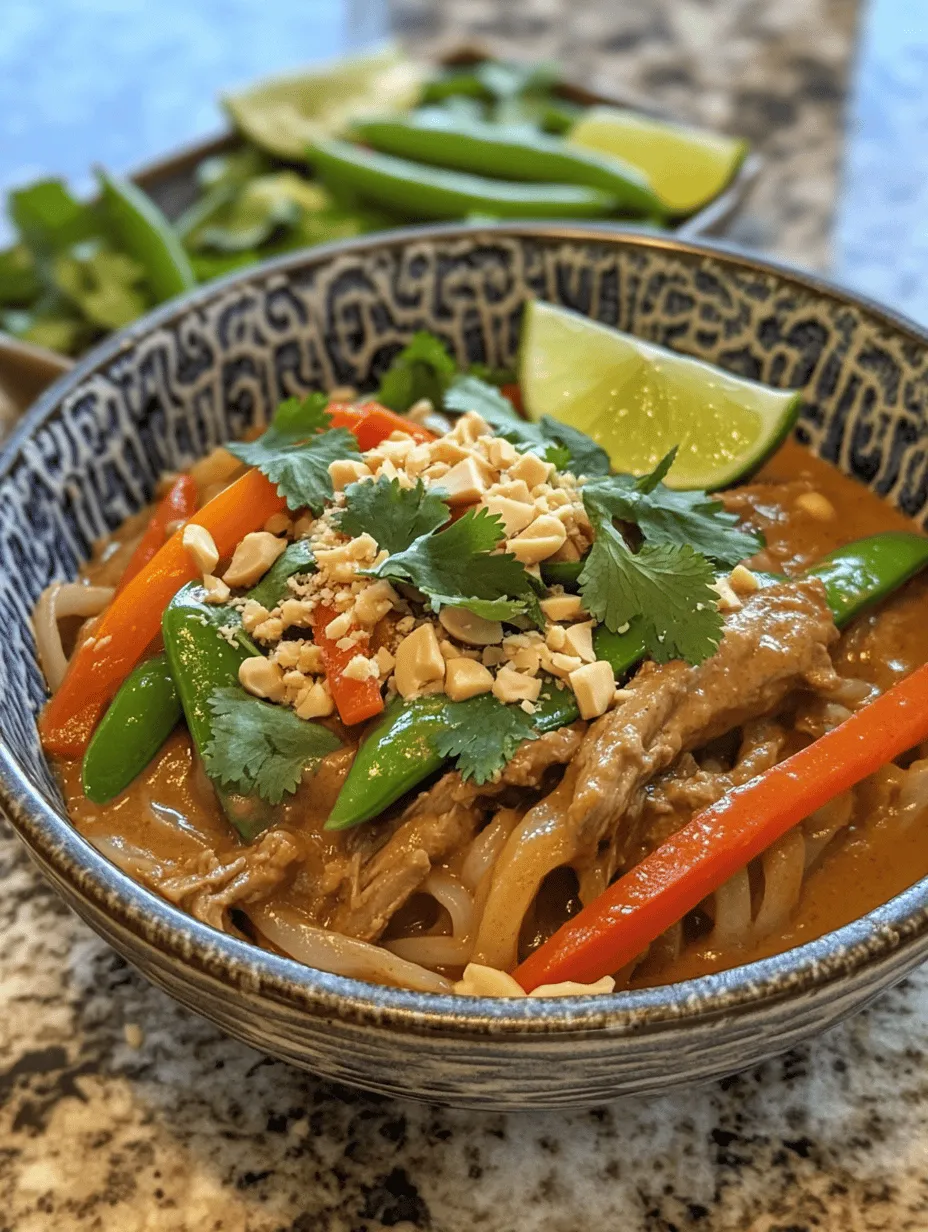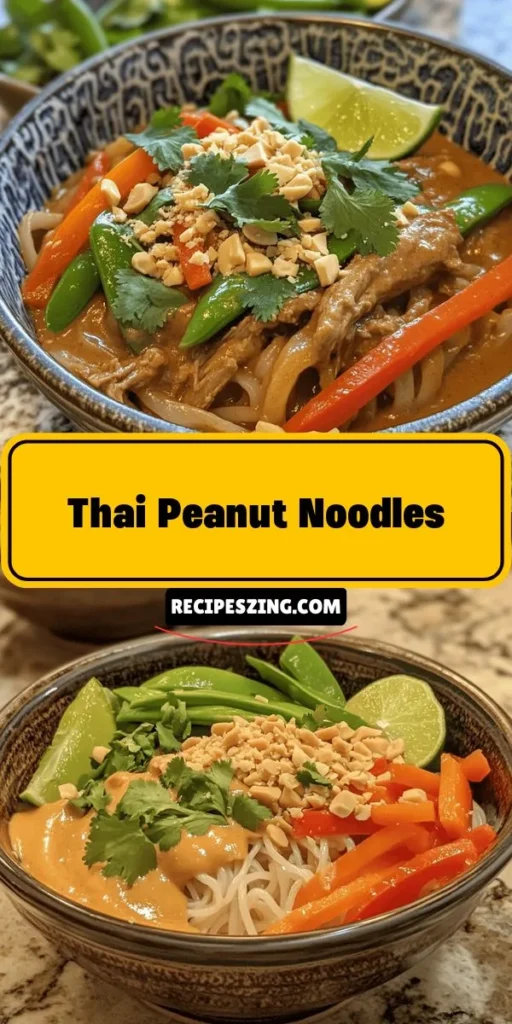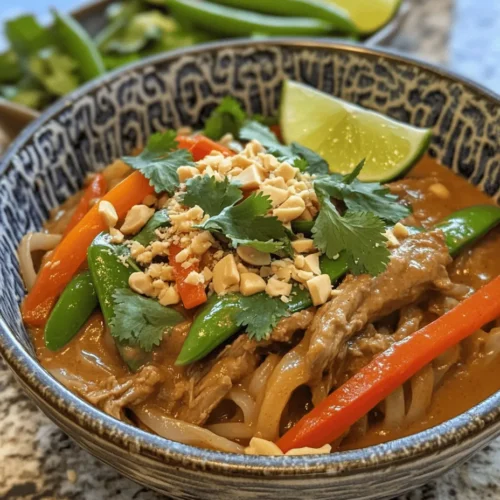Introduction
Thai cuisine is celebrated worldwide for its vibrant flavors, aromatic spices, and fresh ingredients. Its popularity stems from the unique balance of sweet, sour, salty, and spicy elements that tantalize the taste buds while providing a culinary experience that is both satisfying and nourishing. Among the many delightful dishes that Thai cuisine offers, Thai Peanut Noodles stand out as a favorite. This easy-to-make dish is not only delicious but also a fantastic representation of the harmonious blend of flavors and textures found in Thai cooking.
Thai Peanut Noodles feature a rich and creamy peanut sauce that envelops perfectly cooked rice noodles, complemented by a colorful medley of fresh vegetables. The crunch of peanuts and the zing of lime juice add layers of complexity, making each bite a delightful experience. This dish is perfect for busy weeknights, potlucks, or even casual gatherings, as it can be prepared quickly and served warm or cold.
Beyond its incredible taste, Thai Peanut Noodles boast numerous health benefits thanks to their key ingredients. Peanuts provide a source of healthy fats and protein, while the array of vegetables adds essential vitamins and minerals. With this dish, you can indulge in a hearty meal without compromising your health, making it an excellent choice for the whole family.
Understanding the Ingredients
To create a well-balanced and flavorful plate of Thai Peanut Noodles, it’s essential to understand the core ingredients that make up this dish. Each component plays a vital role in the overall flavor profile and texture, contributing to the dish’s appeal.
Rice Noodles
At the heart of Thai Peanut Noodles is rice noodles, which are gluten-free and easy to prepare. There are several types of rice noodles available, including flat rice noodles (often used in Pad Thai) and thin vermicelli noodles. When selecting rice noodles for this recipe, opt for the medium-width rice noodles, as they hold the peanut sauce well and provide a satisfying bite.
Cooking rice noodles is a straightforward process. They can be boiled until tender or soaked in hot water until they are pliable. The key is to achieve an al dente texture, which ensures that the noodles hold their shape when mixed with the sauce. If you’re looking for alternatives, you can also use whole grain or zucchini noodles for a lighter version of this dish.
Peanut Butter
Peanut butter is the star of the sauce that brings Thai Peanut Noodles to life. It adds creaminess and a rich, nutty flavor that pairs beautifully with the other ingredients. When choosing peanut butter, consider using natural varieties that contain minimal additives; this way, you can enjoy the pure taste of peanuts without unnecessary sugars or oils.
Peanut butter is also packed with health benefits, offering a good source of protein, healthy fats, and vitamins such as vitamin E and magnesium. For those with dietary restrictions, alternatives like sunflower seed butter or tahini can be used to maintain the creamy texture while catering to nut-free diets.
Soy Sauce and Hoisin Sauce
To enhance the flavor of the peanut sauce, soy sauce and hoisin sauce are essential. Soy sauce adds saltiness and umami, balancing the sweetness of the peanut butter and any sweeteners used. For a gluten-free option, tamari sauce can be substituted without compromising the dish’s integrity.
Hoisin sauce, often referred to as “Chinese barbecue sauce,” contributes a sweet and tangy flavor with hints of spices. It adds depth to the sauce and complements the nuttiness of the peanut butter. A little goes a long way, so be mindful of the quantity used to achieve the desired taste.
Sweeteners
Sweetness is an integral part of Thai cuisine, often used to balance spicy and savory elements. In this recipe, you can utilize honey or maple syrup as sweeteners for the peanut sauce.
– Honey: It adds natural sweetness and a floral note, enhancing the overall flavor of the sauce. Honey is also known for its antioxidant properties and can provide a natural energy boost.
– Maple Syrup: This alternative offers a distinct flavor profile with earthy undertones. It is vegan-friendly and works well in the sauce, making it suitable for those avoiding animal products.
Fresh Vegetables
Fresh vegetables not only add color and crunch to Thai Peanut Noodles but also provide essential nutrients. Common vegetables used in this dish include:
– Red Bell Pepper: Sweet and crisp, red bell peppers add a pop of color and a rich source of vitamins A and C.
– Carrots: Shredded or julienned, carrots bring a natural sweetness and a satisfying crunch.
– Snap Peas: These tender-crisp peas add a refreshing snap and are rich in fiber and vitamins.
Using a variety of vegetables not only enhances the dish’s nutritional profile but also contributes to its visual appeal. Feel free to customize the vegetable mix based on seasonal availability or personal preferences.
Garnishes
Garnishes play a crucial role in elevating the presentation and flavor of Thai Peanut Noodles. Common garnishes include:
– Green Onions: Sliced green onions add a mild onion flavor and a fresh, vibrant touch to the dish.
– Cilantro: Fresh cilantro lends a burst of herbal flavor and brightens the dish, making it more aromatic.
– Crushed Peanuts: A sprinkle of crushed peanuts provides an extra layer of crunch and reinforces the peanut flavor in the dish.
– Lime Wedges: A squeeze of fresh lime juice enhances the dish’s brightness, adding a tart contrast to the richness of the peanut sauce.
Preparation Steps in Detail
Now that we have a comprehensive understanding of the key ingredients, let’s dive into the preparation steps for making Thai Peanut Noodles. Follow these detailed instructions to create a dish that is sure to impress.
Step 1: Cooking Rice Noodles
1. Boil Water: Start by bringing a large pot of water to a rolling boil. Ensure you have enough water to allow the noodles to move freely while cooking.
2. Add Noodles: Once the water is boiling, add the rice noodles and stir gently to prevent them from sticking together.
3. Cook to Al Dente: Follow the package instructions for cooking times, usually around 5-7 minutes. Taste the noodles occasionally to ensure they reach an al dente texture, which means they should still have a slight bite to them.
4. Drain and Rinse: Once cooked, drain the noodles in a colander and rinse them under cold water. This stops the cooking process and prevents them from becoming mushy. Toss them with a drizzle of oil to keep them from sticking.
Step 2: Preparing the Peanut Sauce
1. Combine Ingredients: In a medium bowl, combine peanut butter, soy sauce, hoisin sauce, and your choice of sweetener.
2. Whisk Until Smooth: Use a whisk or fork to blend the ingredients until you achieve a smooth consistency. If the sauce is too thick, you can thin it out with a little water or coconut milk until you reach your desired texture.
3. Taste and Adjust: Before proceeding, taste the sauce and adjust the flavors as needed. Add more sweetener for sweetness, soy sauce for saltiness, or a splash of lime juice for acidity.
Step 3: Sautéing the Vegetables
1. Heat Oil: In a large skillet or wok, heat a tablespoon of oil over medium-high heat.
2. Add Harder Vegetables First: Start by adding the carrots and red bell pepper, sautéing for about 2-3 minutes until they begin to soften.
3. Add Snap Peas: Next, add the snap peas and continue sautéing for an additional 2-3 minutes. You want the vegetables to be tender yet still crunchy, preserving their color and nutrients.
Step 4: Combining Noodles, Sauce, and Vegetables
1. Add Noodles: Lower the heat to medium and add the drained rice noodles to the skillet with the sautéed vegetables.
2. Pour in Peanut Sauce: Drizzle the prepared peanut sauce over the noodles and vegetables, using tongs or chopsticks to toss everything together gently.
3. Ensure Even Distribution: Continue tossing until the noodles are well-coated in the sauce, and the vegetables are evenly distributed throughout the dish.
Step 5: Serving Suggestions
1. Plate Up: When ready to serve, transfer the Thai Peanut Noodles to individual bowls or a large serving platter for family-style dining.
2. Garnish Generously: Top each serving with sliced green onions, fresh cilantro, crushed peanuts, and lime wedges to enhance the presentation and flavor.
3. Enjoy Warm or Cold: These noodles can be enjoyed warm right after cooking or served cold as a refreshing noodle salad, making them a versatile dish for any occasion.
By following these steps, you’ll create a delightful dish of Thai Peanut Noodles that is flavorful, nourishing, and sure to please. Stay tuned for the next section, where we will explore tips for achieving the best results and answer common questions regarding this beloved recipe.




